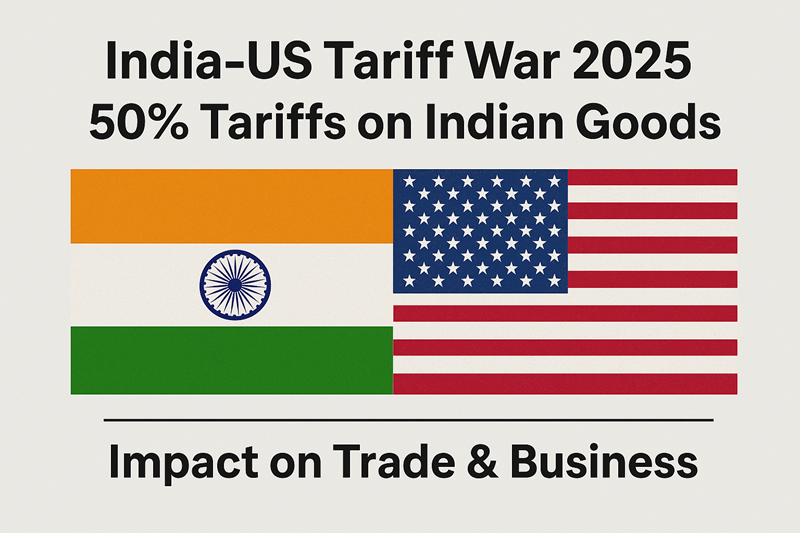The India–US tariff war 2025 has taken a dramatic turn. On August 27, 2025, the United States imposed 50% tariffs on Indian imports, making it one of the most aggressive trade actions in recent history. This sharp escalation, triggered by India’s continued purchases of Russian oil, now threatens to reshape global supply chains and impact industries ranging from textiles and chemicals to gems, jewelry, and footwear.
India–US Trade Relations in Numbers
-
In 2024, India exported nearly $87–88 billion worth of goods to the U.S., its largest single export market.
-
In the first half of 2025, Indian exports to the U.S. reached $56.3 billion, while U.S. exports to India were valued at $22.1 billion.
-
With the new tariff hike, analysts estimate that over half of Indian exports to America could face higher costs, disrupting trade flows and margins.
Which Indian Sectors Are Most Affected?
1. Textiles & Apparel
The textile industry, a cornerstone of India’s exports, faces steep challenges as price-sensitive U.S. buyers look toward alternative sourcing hubs like Vietnam and Bangladesh.
2. Gems & Jewelry
India’s diamond and jewelry exporters, already dealing with weaker luxury demand, now face a dual blow: higher tariffs and shrinking global orders.
3. Chemicals & Specialty Materials
Indian chemical manufacturers supplying raw materials to U.S. packaging, coatings, and consumer goods industries must renegotiate contracts due to higher costs.
4. Footwear, Furniture & Seafood
Low-margin categories that compete mainly on price will be the fastest to lose market share in the U.S.
Why the Tariff War Matters
The India–America tariff conflict is not just about numbers—it is about supply chain resilience, job creation, and global competitiveness. For India, the U.S. market is irreplaceable in the short term, while for American businesses, India offers an alternative to China in the long run.
In June 2023, both nations showed they could resolve disputes when India rolled back tariffs on U.S. farm products like almonds, apples, and walnuts. However, the new tariff hike indicates that political and geopolitical concerns now outweigh trade cooperation.
Strategies for Indian Businesses to Stay Competitive
-
Recalculate landed costs with new tariff rates and renegotiate contracts with U.S. buyers.
-
Diversify export markets in Europe, ASEAN, and the Middle East to reduce dependency on the U.S.
-
Explore dual sourcing—keep complex SKUs in India while shifting simple, low-cost goods to alternate hubs.
-
Leverage government support schemes like PLI (Production Linked Incentive) to offset tariff impacts.
-
Strengthen brand value for premium products so that buyers are willing to absorb partial cost hikes.
Possible Scenarios Ahead
-
Negotiated Settlement (30–40% chance): Both sides soften positions, with partial tariff rollbacks.
-
Tariffs Hold (40–50% chance): U.S. buyers accelerate diversification, while Indian exporters offer price cuts.
-
Tit-for-Tat Escalation (10–20% chance): India retaliates with duties on U.S. goods, creating wider market disruptions.
What Businesses Should Watch
The India–US tariff war is more than just a trade story—it is a business survival challenge. With tariffs as high as 50%, India’s most competitive industries are facing immediate pressure. Exporters must adapt quickly with smarter pricing, stronger supply chain strategies, and market diversification.
While politics may eventually lead to de-escalation, businesses that act now will safeguard their market presence and emerge stronger in a turbulent global trade environment.

